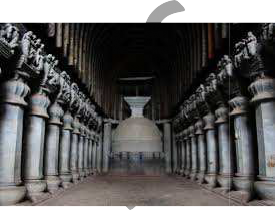5.1 Caves Tradition

In western India, many Buddhist caves dating back to the second century BCE onwards have been excavated. Mainly three architectural types were executed – (1) Apsidal Vault – Roof Chaitya halls (found at Ajanta, Pithalkhora,
Bhaja); (2) Apsidal Vault – Roof pillarless hall (found at Thana – Nadsur); and (3) Flat- Roofed quadrangular hall with a circular chamber at
back (found at Kondivite). In all the caves a stupa at the back is common.
The second important development
chaitya
in the
caves was excavation of Viharas. The plan of
viharas consists of a veranda, a hall and cells
around the walls of the halls. Some of the

Vihara
Residence/
Rest place of Monks
important vihara caves are Ajanta Cave no. 12, Bedsa cave no. 11, Nashik cave no. 3, 10, 17.

Chaitya
Prayer hall
for monks
